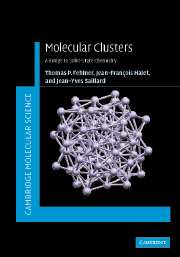Book contents
- Frontmatter
- Contents
- Preface
- 1 Introduction
- 2 Main-group clusters: geometric and electronic structure
- 3 Transition-metal clusters: geometric and electronic structure
- 4 Isolobal relationships between main-group and transition-metal fragments. Connections to organometallic chemistry
- 5 Main-group–transition-metal clusters
- 6 Transition to the solid state
- 7 From molecules to extended solids
- 8 Inter-conversion of clusters and solid-state materials
- Appendix: Fundamental concepts: a concise review
- Problem Answers
- References
- Index
- References
5 - Main-group–transition-metal clusters
Published online by Cambridge University Press: 19 February 2010
- Frontmatter
- Contents
- Preface
- 1 Introduction
- 2 Main-group clusters: geometric and electronic structure
- 3 Transition-metal clusters: geometric and electronic structure
- 4 Isolobal relationships between main-group and transition-metal fragments. Connections to organometallic chemistry
- 5 Main-group–transition-metal clusters
- 6 Transition to the solid state
- 7 From molecules to extended solids
- 8 Inter-conversion of clusters and solid-state materials
- Appendix: Fundamental concepts: a concise review
- Problem Answers
- References
- Index
- References
Summary
A large number of mixed main-group–transition-metal clusters can be understood with isolobal ideas and the electron-counting rules. However, there is a growing number that cannot. These clusters are more closely related to metal clusters than main-group clusters. In this chapter we begin with a survey of the “rule-abiding” mixed-element clusters with emphasis on variety rather than comprehensiveness. Why a cursory survey? Because with a solid background of main-group and transition-metal cluster behavior under our belts, the isolobal analogy permits a ready understanding of mixed systems that follow the rules. Understanding permits prediction of possible stoichiometry and structure thereby generating goals for future synthesis.
It is the second compound type that constitutes an interesting challenge to our views of cluster electronic structure. With this compound type we encounter a structural response arising from main-group and transition-metal atom competition within the context of a molecular cluster. This competition generates both cluster shapes invariant to change in electron count as well as new cluster-structure types associated with unusual electron counts. Both pose a problem of interpretation. But the problem is a worthwhile one as structures that deviate from the electron-counting rules contain information on the electronic factors that underlie cluster chemistry in general. “Failure” of the rules actually constitutes a gateway leading to compounds with hybrid properties not accessible with either pure main-group or transition-metal clusters. Useful chemistry is all about properties and the more ways we develop to vary and control properties the better off we are.
- Type
- Chapter
- Information
- Molecular ClustersA Bridge to Solid-State Chemistry, pp. 165 - 204Publisher: Cambridge University PressPrint publication year: 2007



